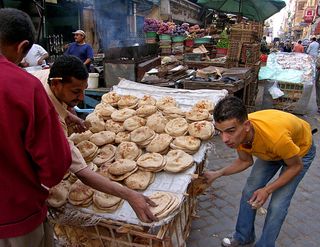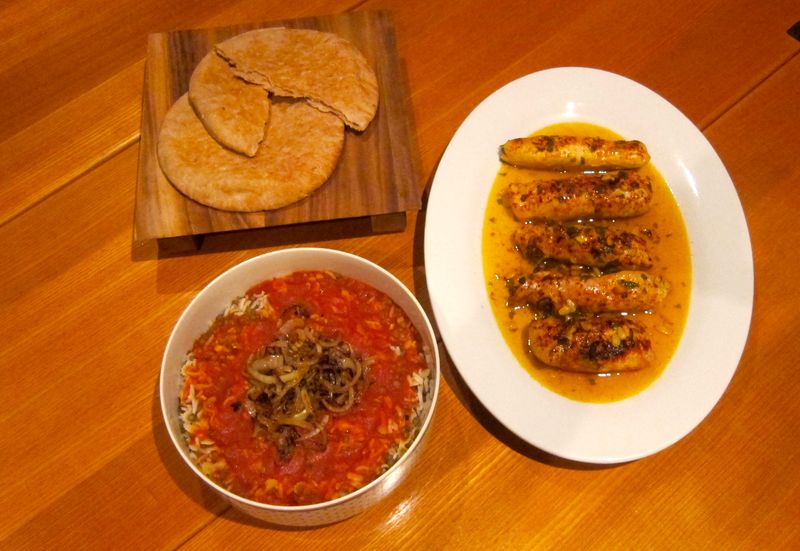Bread has been an important element in the eating traditions of many cultures since the dawn of the Neolythic Age some 12,000 years ago and to this day, it forms the backbone of Egyptian cuisine. There is evidence that leavened bread was discovered/invented in
 Egypt around 1600 B.C. and that over the next few centuries, they developed ovens that enabled large scale baking. Archaeological excavations have found that workers on the
Egypt around 1600 B.C. and that over the next few centuries, they developed ovens that enabled large scale baking. Archaeological excavations have found that workers on the
Great Pyramids of Giza were paid in bread, beer and onions. Bad pharaohs! The workers should have complained that this diet did not comply with the USDA Food Pyramid for daily recommended intake.
In midieval Europe, rounds or squares of dry bread called trenchers (from the French "to cut or slice") were used to place food upon before eating it.
 The trencher served as a primitive plate and absorbed the juice or sauce; it could also be eaten at the diner's pleasure. One could rightly describe these as "edible utensiles" and in modern day Egypt, bread still has this very function in addition to being a primary source of protein and carbohydrate.
The trencher served as a primitive plate and absorbed the juice or sauce; it could also be eaten at the diner's pleasure. One could rightly describe these as "edible utensiles" and in modern day Egypt, bread still has this very function in addition to being a primary source of protein and carbohydrate.
In Egypt, a form of pita bread called Eish Masri is consumed at nearly every meal.
 Egyptians use their bread to scoop up food, sauces, and dips and to wrap kebabs, falafel and the like in the manner of sandwiches. Most pita breads are baked at high
Egyptians use their bread to scoop up food, sauces, and dips and to wrap kebabs, falafel and the like in the manner of sandwiches. Most pita breads are baked at high
temperatures (450°F or 232°C), causing the flattened rounds of dough to puff up dramatically. When removed from the oven, the layers of baked dough remain separated inside the deflated pita, which allows the bread to be opened into pockets, creating a space for use in various dishes.
Here are some typical Egyptian dishes: Ful medames, a dish of cooked and mashed fava beans served with olive oil, chopped parsley, onion, garlic and lemon juice; Shawarma, a meat preparation, where, lamb, goat, chicken, turkey, beef, veal, or mixed meats are placed on a spit (commonly a vertical spit inrestaurants), and may be grilled for as long as a day; Kebab, a wide variety of skewered meals originating in the Middle East; Felafel, a deep-fried ball or patty made from ground chickpeas, fava beans or both; Baba Ghannoug, eggplant (aubergine) mashed and mixed with virgin olive oil and various seasonings; Baklava, sweet pastry made of layers of filo pastry filled with chopped nuts and sweetened with syrup or honey.
Here is Josée's midweek Egyptian menu:
Chicken Roulade
The chicken roulade - mallet tenderized chicken breasts are stuffed with onions, pine nuts, lemon zest and parsley then baked in the oven with olive oil and lemon juice.
Kosheri is considered by many to be the national dish of Egypt. It consists of a mixture of rice, pasta and lentils. A tomato sauce made with garlic and red wine vinegar is then poured over the rice and pasta mixture. The dish is finished with a sprinkle of browned onions.
It being an on-call night for yous truly, the meal was accompanied by sparkling water.
Joseph Froncioni









































































































Comments